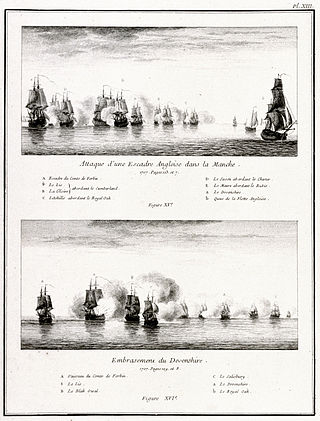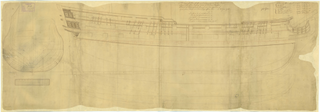
HMS Theseus was a 74-gun third-rate ship of the line of the Royal Navy.

HMS Cornwall was an 80-gun, third rate, ship of the line built for the Royal Navy in the 1690s. She served in the War of the Grand Alliance, and in her first year took part in the Battle of Barfleur and the action at La Hougue.

HMS Royal Oak was a 74-gun third-rate ship of the line of the Royal Navy, built by Jonas Shish at Deptford and launched in 1674. She was one of only three Royal Navy ships to be equipped with the Rupertinoe naval gun. Life aboard her when cruising in the Mediterranean Sea in 1679 is described in the diary of Henry Teonge.

HMS Northumberland was a 70-gun third-rate ship of the line of the Royal Navy, built at Deptford Dockyard and launched in 1705.

HMS Duke was a 90-gun second-rate ship of the line of the Royal Navy, launched on 13 June 1682 at Woolwich Dockyard.

HMS Hero was a 74-gun third rate of the Royal Navy, launched on 18 August 1803 at Blackwall Yard.

HMS Charles was a 96-gun first-rate ship of the line of the Royal Navy, built by Christopher Pett at Deptford Dockyard until his death in March 1668, then completed by Jonas Shish after being launched in the same month. Her name was formally Charles the Second, but she was known simply as Charles, particularly after 1673 when the contemporary Royal Charles was launched.

HMS Falkland was a 50-gun fourth-rate ship of the line of the Royal Navy, built by Holland of New Castle, New Hampshire, and purchased by the navy in 1696.

President was a 38-gun fourth rate frigate of the Royal Navy, originally built for the navy of the Commonwealth of England by Peter Pett I at Deptford Dockyard, and launched in 1650.

HMS Salisbury was a 50-gun fourth rate ship of the line of the Royal Navy, one of eight such ships authorised by the Navy Board on 24 December 1695 to be newly built ; the others were the Hampshire, Dartmouth, Winchester, Worcester, Jersey, Carlisle and Tilbury. The contract for the Winchester was signed with shipbuilders Richard and James Herring in 1696, for the ship to be built in their yard at Baileys Hard on the Beaulieu River in Hampshire, England, and she was launched there on 18 April 1698.

HMS Canterbury was a 60-gun fourth-rate ship of the line of the Royal Navy, launched at Deptford on 18 December 1693.

HMS Ipswich was a 70-gun third-rate ship of the line of the Royal Navy, launched at Harwich on 19 April 1694.
HMS Triumph was a 90-gun second rate ship of the line of the Royal Navy, launched at Chatham Dockyard on 2 March 1697. She was renamed HMS Prince in 1714.

HMS Swiftsure was a 70-gun third-rate ship of the line of the Royal Navy, launched in 1755 and in active service during the Seven Years' War. After a distinguished career at sea she was decommissioned in 1763 and sold into private hands ten years later.
HMS Norwich was a 50-gun fourth rate ship of the line of the Royal Navy, launched at Deptford on 24 August 1693. The last of seven 50-gun ships ordered during 1692, she was given the name of Norwich following the loss of the previous 50-gun ship of that name on 6 October 1692.

HMS Dartmouth was a 50-gun fourth-rate ship of the line of the Royal Navy, one of eight such ships authorised by the Navy Board on 24 December 1695 to be newly built ; the others were the Hampshire, Winchester, Salisbury, Worcester, Jersey, Carlisle and Tilbury. The contract for the Dartmouth was signed in 1696 with shipbuilder James Parker, for the ship to be built in his site in Southampton, taking the name of the previous Dartmouth of 1693, and she was launched there on 3 March 1698.
HMS Dartmouth was a 50-gun fourth rate ship of the line of the English Royal Navy, ordered on 21 June 1692 to be built by commercial contract with the master shipwright John Shish in Rotherhithe, and launched there on 24 July 1693.
HMS Falmouth was a 50-gun fourth-rate ship of the line built for the Royal Navy in the first decade of the 18th century. The ship participated in several battles during the War of the Spanish Succession (1701–15) and the War of Jenkins' Ear (1739–48).

HMS Gloucester was a 50-gun fourth-rate ship of the line built at Deptford by Joseph Allin the elder for the Royal Navy in 1710/11. She participated in the War of the Spanish Succession. The ship was burned to prevent capture after she was damaged in a storm during Commodore George Anson's voyage around the world in 1742.
HMS Sunderland was a 60-gun fourth rate ship of the line of the Royal Navy, built to the 1719 Establishment at Chatham Dockyard, and launched on 30 April 1724.
















